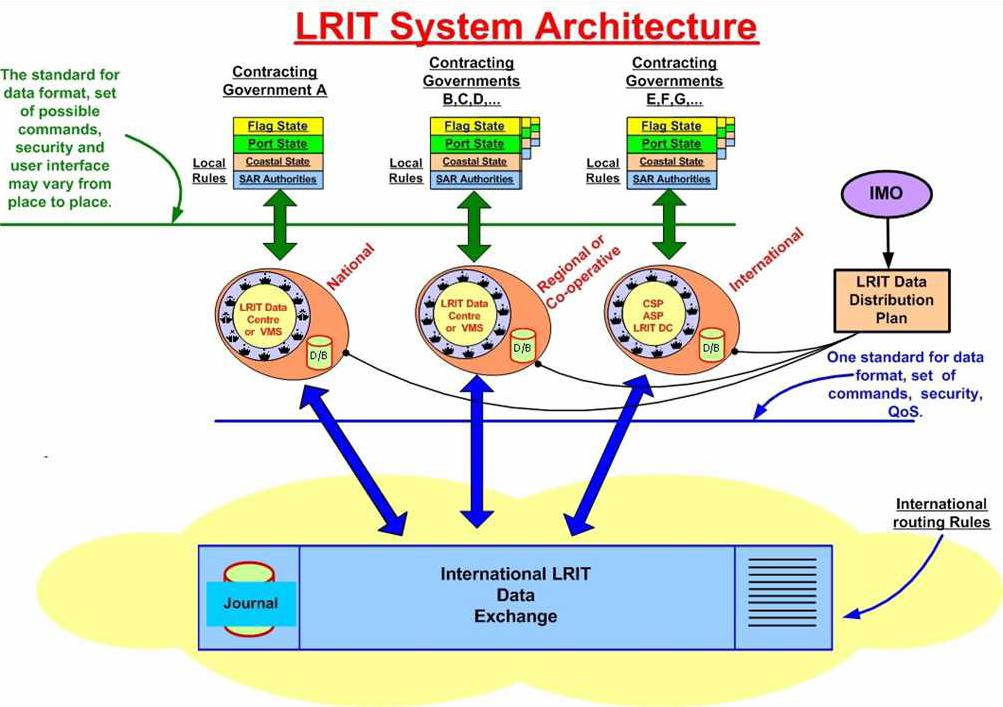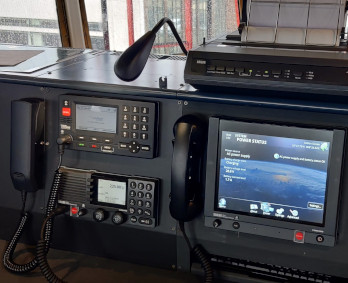What is LRIT?
Overview
As part of the international maritime community’s wide-ranging response to the growing threat from terrorism worldwide, the International Maritime Organization (IMO) decided to establish a new system for the global identification and tracking of ships. Following a major effort to identify appropriate technologies, establish the necessary global legal regime and achieve political consensus concerning the collection, distribution and use of the data, IMO has established a system for the Long-Range Identification and Tracking of Ships (LRIT).
The LRIT system consists of shipborne LRIT information transmitting equipment, Communication Service Provider(s), Application Service Provider(s), LRIT Data Centre(s), the LRIT Data Distribution Plan and the International LRIT Data Exchange. Certain aspects of the performance of the LRIT system are reviewed or audited by the LRIT Coordinator acting on behalf of all Contracting Governments to the International Convention for the Safety of Life at Sea (SOLAS). IMSO has been appointed to be the LRIT Coordinator.
Under SOLAS Regulation V/19-1, ships are required to report their position (LRIT information) automatically, to a special shore data collection, storage and distribution system, at least four times a day. LRIT information is provided to Contracting Governments and Search and Rescue services entitled to receive the information, upon request, through a system of National, Regional, and Co operative LRIT Data Centres, using where necessary, the International LRIT Data Exchange.
An overview of the general structure of the international LRIT system, with a summary of the most important LRIT functions and requirements are provided below. The information provided below does not supersede SOLAS Regulation V/19.1 or any of the supporting resolutions promulgated by IMO, which should always be consulted for definitive information.

Regulatory Basis for LRIT
The obligations of ships to transmit LRIT information and the rights and obligations of Contracting Governments and of SAR services to receive LRIT information are established in regulation V/19-1 of the 1974 SOLAS Convention.
IMO has also established a series of Assembly Resolutions and MSC Circulars that provide details of the technical and operational criteria, and arrangements for the implementation of the LRIT system world wide. These circular are available at: https://www.imo.org/en/OurWork/Safety/Pages/LRIT.aspx
Individual Flag States are expected to publish specific regulations for the ships on their Register providing detailed guidance on the implementation of LRIT, including ship equipment conformance test arrangements, plus the Application Service Provider(s) and Data Centre chosen by the Flag concerned.
The regulations that require ships to participate in the LRIT system apply to the following types of ships engaged on international voyages:
• passenger ships, including high-speed passenger craft;
• cargo ships, including high-speed craft, of 300 gross tonnage and upwards;
• and mobile offshore drilling units.
Shipborne Equipment
The “shipborne equipment” utilised for LRIT can be any communications terminal on board the vessel that is capable of automatically transmitting the ship’s LRIT information, without human intervention, at 6-hourly intervals to an LRIT data centre.
In addition, the shipboard equipment must be capable of:
• being configured remotely to transmit LRIT information at variable intervals;
• transmitting LRIT information on receipt of a specific request from the shore (ie when polled); and
• being interfaced with an external global navigation satellite receiver (eg GPS), or have an internal positioning capability.
It must also meet a number of specific environmental and installation requirements, including the general requirements for shipborne radio equipment forming part of the global maritime distress and safety system (GMDSS) set out in IMO resolution A.694(17).


LRIT Information
The LRIT Information that is required to be transmitted by the ship is specified in new SOLAS Regulation V/19-1.5 and is limited to:
• identity of the ship;
• position of the ship (latitude and longitude);
• date and time of the position provided.
Application Service Provider(s)
The Application Service Provider (ASP) receives the LRIT reports transmitted by the ship via the CSP, adds certain additional information to each report, and forwards the reports to the Data Centre nominated by the ship’s Flag State. The information to be added to each LRIT report by the ASP includes:
• IMO ship identification number and MMSI for the ship;
• name of the ship;
• unique identification code for the LRIT Data Centre; and
• a number of time stamps used for tracking and audit purposes.
In addition, the ASP is responsible for testing and configuring the ship’s communications terminal, both when the terminal is new and during continued LRIT reporting, including executing “on demand” transmissions of LRIT data.
Experience has shown that ship’s communication terminals do not always continue reporting automatically without further intervention, and the ASP is responsible for identifying when a terminal has ceased automatic reporting for any reason and resetting its reporting function when required.
Lastly, the ASP must ensure that LRIT information is collected, stored and routed in a reliable and secure manner.
The ASP is will often be a commercial entity, and is chosen and recognized by a Contracting Government to provide LRIT Data to their Data Centre.
Communication Service Provider(s)
The Communication Service Provider (CSP) provides the communications services which transfer LRIT data securely from ship to the ASP on shore. The means of communication will often be via satellite, but the LRIT system itself is independent of the means of communication, and any method can be used, as long as the correct packet of data arrives on shore at the right periodicity or when demanded. The IMO Performance Standard requires that:
“The shipboard equipment should transmit the LRIT information using a communication system which provides coverage in all areas where the ship operates.”

A Communication Service Provider (CSP) site


